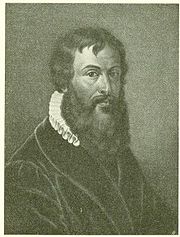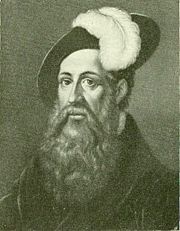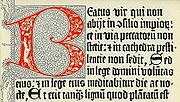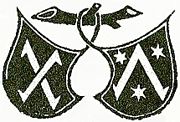
Peter Schöffer
Encyclopedia




Gernsheim
Gernsheim is a town in Groß-Gerau district and Darmstadt region in Hesse, Germany, lying on the Rhine.-Location:The Schöfferstadt Gernsheim, as Gernsheim may officially call itself – it was Peter Schöffer's birthplace – lies 18 km southwest of Darmstadt and 16 km northeast of Worms, right...
, Groß-Gerau
Groß-Gerau (district)
Groß-Gerau is a Kreis in the south of Hesse , Germany. Neighboring districts are Main-Taunus, district-free Frankfurt, Darmstadt-Dieburg, Bergstraße, Alzey-Worms, Mainz-Bingen, and the district-free cities Mainz and Wiesbaden....
- 1503 Mainz
Mainz
Mainz under the Holy Roman Empire, and previously was a Roman fort city which commanded the west bank of the Rhine and formed part of the northernmost frontier of the Roman Empire...
) was an early German printer, who studied in Paris
Paris
Paris is the capital and largest city in France, situated on the river Seine, in northern France, at the heart of the Île-de-France region...
and worked as a manuscript copyist in 1451 before apprenticing with Johannes Gutenberg and joining Johann Fust
Johann Fust
Johann Fust was an early German printer.- Family background :Fust belonged to a rich and respectable burgher family of Mainz, traceable back to the early thirteenth-century; members of the family held many civil and religious offices.The name was always written Fust, but in 1506 Peter Schöffer, in...
, a goldsmith, lawyer, and money lender.
Life and works
Working for Fust, Schöffer was the principal workman of Johannes Gutenberg, inventor of modern typographyTypography
Typography is the art and technique of arranging type in order to make language visible. The arrangement of type involves the selection of typefaces, point size, line length, leading , adjusting the spaces between groups of letters and adjusting the space between pairs of letters...
, whose 42-Line Bible
Gutenberg Bible
The Gutenberg Bible was the first major book printed with a movable type printing press, and marked the start of the "Gutenberg Revolution" and the age of the printed book. Widely praised for its high aesthetic and artistic qualities, the book has an iconic status...
was completed in 1455. In 1455 he testified for Johann Fust against Gutenberg. By 1457 he and Fust had formed the firm Fust and Schöffer, after the foreclosure of the mortgage on Gutenberg's printing workshop.

Punchcutting
In traditional typography, punchcutting is the craft of cutting letter punches in steel from which matrices were made in copper for type founding in the letterpress era. Cutting punches and casting type was the first step of traditional typesetting. The cutting of letter punches was a highly...
and type-founding
Type foundry
A type foundry is a company that designs or distributes typefaces. Originally, type foundries manufactured and sold metal and wood typefaces and matrices for line-casting machines like the Linotype and Monotype machines designed to be printed on letterpress printers...
, and using colored inks in print. After going into business on his own, Schöffer confined his publishing to works on theology, and civil and ecclesiastical law.
Schöffer married Fust's only daughter, Christina, and his sons also entered the printer's trade. His son John carried on as printer between 1503 and 1531, was competent, but did not rank with the top printers of that time. Another son, Peter the younger, was an able die-cutter and printer, and conducted business in Mainz
Mainz
Mainz under the Holy Roman Empire, and previously was a Roman fort city which commanded the west bank of the Rhine and formed part of the northernmost frontier of the Roman Empire...
(1509–23), Worms
Worms, Germany
Worms is a city in Rhineland-Palatinate, Germany, on the Rhine River. At the end of 2004, it had 85,829 inhabitants.Established by the Celts, who called it Borbetomagus, Worms today remains embattled with the cities Trier and Cologne over the title of "Oldest City in Germany." Worms is the only...
(1512–29), Strasburg
Strasbourg
Strasbourg is the capital and principal city of the Alsace region in eastern France and is the official seat of the European Parliament. Located close to the border with Germany, it is the capital of the Bas-Rhin département. The city and the region of Alsace are historically German-speaking,...
(1530–39) and Venice
Venice
Venice is a city in northern Italy which is renowned for the beauty of its setting, its architecture and its artworks. It is the capital of the Veneto region...
(1541–42). In 1526, Peter Schöffer the younger published the first English New Testament in Worms
Worms, Germany
Worms is a city in Rhineland-Palatinate, Germany, on the Rhine River. At the end of 2004, it had 85,829 inhabitants.Established by the Celts, who called it Borbetomagus, Worms today remains embattled with the cities Trier and Cologne over the title of "Oldest City in Germany." Worms is the only...
, translated by William Tyndale
William Tyndale
William Tyndale was an English scholar and translator who became a leading figure in Protestant reformism towards the end of his life. He was influenced by the work of Desiderius Erasmus, who made the Greek New Testament available in Europe, and by Martin Luther...
. Peter the younger's son Ivo, continued the printing business at Mainz (1531–55).
Legacy
Schöfferhofer is a brand of German wheat beer named for the former house of Peter Schöffer (the house was called the Mainzer Schöfferhof) in which a breweryBrewery
A brewery is a dedicated building for the making of beer, though beer can be made at home, and has been for much of beer's history. A company which makes beer is called either a brewery or a brewing company....
was founded. This brand of beer sports a portrait of Peter Schöfferhofer as its trademark. The Schöfferhofer brand originates from this brewery in Mainz
Mainz
Mainz under the Holy Roman Empire, and previously was a Roman fort city which commanded the west bank of the Rhine and formed part of the northernmost frontier of the Roman Empire...
, which is also known as the Brauerei Dreikönigshof.
Further reading
- Peter Schöffer: Herbarius Latinus. Mainz, 1484 (1 CD-ROM für Mac/PC; PDF-Format, nach dem Exemplar aus der Universitätsbibliothek Erlangen-Nürnberg, Sammlung Trew). Harald Fischer Verlag, Erlangen 2005, ISBN 3-89131-430-2
- Michael Giesecke: Der Buchdruck in der frühen Neuzeit: eine historische Fallstudie über die Durchsetzung neuer Informations- und Kommunikationstechnologien. (= stw; 1357). Suhrkamp, Frankfurt am Main 1998, ISBN 3-518-28957-8
- „Gutenberg, aventur und kunst“. Vom Geheimunternehmen bis zur ersten Medienrevolution. Hrsg. von der Stadtverwaltung Mainz. Schmidt, Mainz 2000, ISBN 3-87439-507-3
- Hellmut Lehmann-Haupt: Peter Schöffer aus Gernsheim und Mainz. Reichert, Wiesbaden 2003, ISBN 3-89500-210-0 (Übersetzung der Ausgabe Rochester, N.Y. 1950, Digital version of original ed.)
- Aloys Ruppel: Peter Schöffer aus Gernsheim. Festvortrag zur Hundertjahrfeier der Errichtung des Schöfferdenkmals, gehalten im Rathause zu Gernsheim am 27. Sept. 1936. Gutenberg-Gesellschaft, Mainz 1937
- Carola Schneider: Peter Schöffer, Bücher für Europa. Gutenberg-Gesellschaft, Mainz 2003, ISBN 3-9805506-7-2
- Rudolf Schmidt: Deutsche Buchhändler. Deutsche Buchdrucker. Beiträge zu einer Firmengeschichte des deutschen Buchgewerbes. Buchdruckerei Franz Weber, Berlin, 1902–1908, 1. bis 6. Bd.(Online bei Zeno org.)

